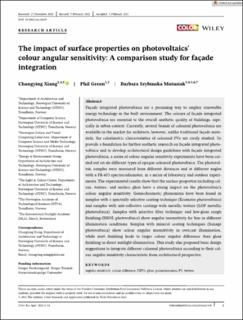| dc.contributor.author | Xiang, Changying | |
| dc.contributor.author | Green, Philip John | |
| dc.contributor.author | Matusiak, Barbara Szybinska | |
| dc.date.accessioned | 2021-03-08T14:17:10Z | |
| dc.date.available | 2021-03-08T14:17:10Z | |
| dc.date.created | 2021-03-06T11:42:49Z | |
| dc.date.issued | 2021 | |
| dc.identifier.issn | 0361-2317 | |
| dc.identifier.uri | https://hdl.handle.net/11250/2732224 | |
| dc.description.abstract | Façade integrated photovoltaics are a promising way to employ renewable energy technology in the built environment. The colours of façade integrated photovoltaics are essential to the overall aesthetic quality of buildings, especially in urban context. Currently, several brands of coloured photovoltaics are available in the market for architects, however, unlike traditional façade materials, the colorimetric characteristics of coloured PVs are rarely studied. To provide a foundation for further aesthetic research on façade integrated photovoltaics and to develop architectural design guidelines with façade integrated photovoltaics, a series of colour angular sensitivity experiments have been carried out on six different types of opaque coloured photovoltaics. The photovoltaic samples were measured from different distances and at different angles with a PR-655 spectroradiometer, in a series of laboratory and outdoor experiments. The experimental results show that the surface properties including colour, texture, and surface gloss have a strong impact on the photovoltaic's colour angular sensitivity. Goniochromatic phenomena have been found in samples with a spectrally selective coating technique (Kromatix photovoltaics) and samples with anti-reflective coatings with metallic texture (LOF metallic photovoltaics). Samples with selective filter technique and low-gloss rough finishing (ISSOL photovoltaics) show angular insensitivity for hue in different illumination conditions. Samples with mineral coating techniques (Sunage photovoltaics) show colour angular insensitivity in overcast illumination, while matt finishing leads to larger colour angular difference than gloss finishing in direct sunlight illumination. This study also proposed basic design suggestions to integrate different coloured photovoltaics according to their colour angular sensitivity characteristic from architectural perspective. | en_US |
| dc.language.iso | eng | en_US |
| dc.publisher | Wiley Online Library | en_US |
| dc.rights | Navngivelse 4.0 Internasjonal | * |
| dc.rights.uri | http://creativecommons.org/licenses/by/4.0/deed.no | * |
| dc.title | The impact of surface properties on photovoltaics' colour angular sensitivity: A comparison study for façade integration | en_US |
| dc.type | Peer reviewed | en_US |
| dc.type | Journal article | en_US |
| dc.description.version | publishedVersion | en_US |
| dc.source.journal | Color Research and Application | en_US |
| dc.identifier.doi | 10.1002/col.22639 | |
| dc.identifier.cristin | 1896040 | |
| dc.description.localcode | This is an open access article under the terms of the Creative Commons Attribution-NonCommercial-NoDerivs License, which permits use and distribution in any medium, provided the original work is properly cited, the use is non-commercial and no modifications or adaptations are made. © 2021 The Authors. Color Research and Application published by Wiley Periodicals LLC. | en_US |
| cristin.ispublished | true | |
| cristin.fulltext | original | |
| cristin.qualitycode | 1 | |

